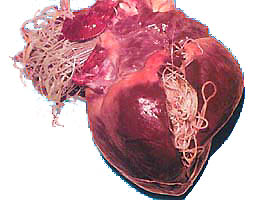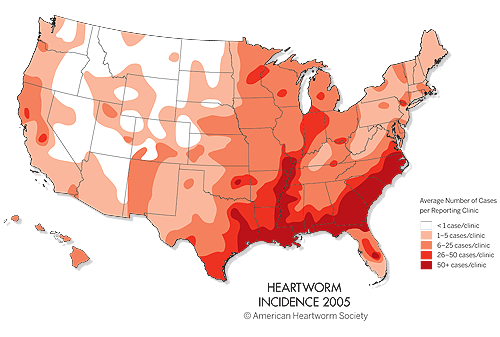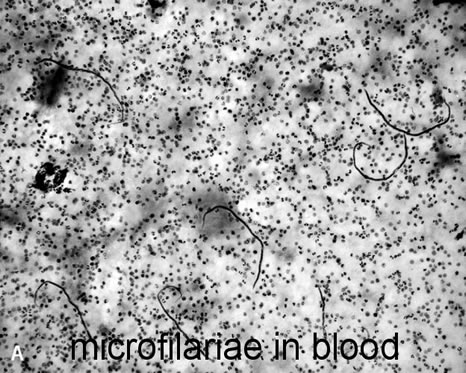Heartworm in Malamutes (or any dog)
Heartworms are parasitic round worms (Dirofilaria immitis) that are spread from dog to dog by way of the mosquito. A heartworm is a small thread-like worm that usually infects dogs, but can also infect cats, woles, coyotes, foxes, ferrets, sea lions and rarely, humans. It's called heartworm because the adult worms end up in the heart – but for most of their life actually live in the blood of the lung's arteries. Because of this, it causes damage to the lungs of healthy dogs if allowed to remain there.
Symptoms
Dogs show no outward symptoms if they have heartworm until it has been present about 6 months, this may be sooner in a puppy. Once the worms mature they can migrate to the heart, and occasionally end up in the eye, brain or an artery in the leg which can result in symptoms such as blindness, seizures, and lameness. Normally they congregate in the heart, where they produce no symptoms or signs of illness until the infestation is severe. Fluid retention in the lungs and the abdomen may result from a severe heartworm infestation and cause coughing, usually due to this fluid. ln some cases, the parasites infect and damage the vascular system in the liver. This spread of the disease can result in jaundice in the animal. This symptom is most visible in the dog's eyes. If it's a puppy, the yellow color indicative of jaundice may be difficult to see.
If a dog lives a sedentary lifestyle, and it's a light infestation, you might never know. Early signs include a mild cough, and exhaustion on exercise. In advance cases where they build up in the heart without treatment, signs can eventually lead to lost weight, fainting, coughing up blood, and congestive heart failure.
There are several ways to detect heartworms, but the most common is by microscopic examination of the blood. This is what your vet uses for routine screening. The test is not completely accurate, which is why they require you to retest every year. Also, this test cannot detect adult heartworms – which is why it's important to keep your dog on preventative and check every year for the microscopic worms that may be present in the blood.. Once they grow up, a different test is required. This test is an antigen test that looks for antibodies in the blood that attack the microfilaria. The downside is it can only detect female worms - and hence will produce negative results during the first 5–8 months of infection until there are enough female worms to detect. Xrays are used to evaluate the amount of lung damage done by the worms, once you know the dog has heartworm.
If an animal is diagnosed with heartworms, treatment may be indicated. Sometimes, if the dog is quite old and doing ok, it's better to just give heartworm medicine to slow or stop additional worms from growing and let the dog live out its life. This is because the treatment is quite dangerous, particularly for an older or compromised dog. This is why before the worms can be treated, the dog must be evaluated for heart, liver, and kidney function to evaluate the risks of treatment. Arsenic compounds are used to kill the adult worms.
After treatment, the dog must rest crated for several weeks so as to give its body sufficient time to absorb the dead worms. Otherwise, if the dog is too active, dead worms may break loose and travel to the lungs, potentially causing respiratory failure and death.
The course of treatment is not completed until several weeks later when the microfilariae circulating in the blood are killed separately using ivermectin. Once heartworm tests are negative, the treatment is considered done. Surgical removal of the adult heartworms is also an option, usually they only do this in advanced cases with substantial heart involvement. It is very dangerous surgery because the heart is involved so usually other treatment options are attempted first.
Sometimes a long term monthly administration of ivermectin year round at three times the normal dose is used for heartworm prevention and removal because over time it will eventually kill adult heartworms.. This is the method many rescues use. However, this is not the preferred way to remove them for two reasons. First, this treatment is not as effective as melarsamine. More importantly, adult heartworms do not begin to die until 18 months later, which allows the worm infestation to get worse before it gets better.
At this time no homeopathic or natural products have been proven effective by rigorous scientific methods, and the choice of using them should be evaluated carefully.
Preventing Heartworms
Prevention of heartworm infection can be obtained through a number of drugs. The drugs approved for use in the US are ivermectin (sold under the brand names Heartgard, Iverhart, and several other generic versions), milbemycin (Interceptor Flavor Tabs and Sentinel Flavor Tabs) and moxidectin ProHeart) administered as pills or chewable tablets. There was some controversy some years ago about the heartworm daily tablets given to Malamutes. They were causing liver damage. I'm not sure if this has been rectified, so it may be something to ask your vet if you prefer daily dosing to monthly dosing. While ivermectin is a very safe drug in the scheme of things – even overdosing a little is not going to hurt your dog. If you are using the Heartgard 50-85 lb dosage for example, you are overdosing a 50 lb. dog with the 85 lb. dose. It won't hurt him, but be aware that is what is happening.
Where cost is a factor, some veterinarians have made up a liquid version using injectible cattle or swine ivermectin cut to acceptable levels with propylene glycol. This is a much less expensive way to dose multiple dogs but you must be careful to determine the dosages properly. It's easy to overdose your dog (especially small dogs) if not careful. I knew a breeder once that used horse paste ivermectin to do all of her dogs – but she didn't realize she was overdosing them at 37 times the proper level because her math was off. If you mix your own Ivermectin using Cattle or Swine Ivermectin, you can actually dose your dog more accurately – but your math must be accurate (which is why I say have your vet help with this). It is also MUCH less expensive for multiple dogs (probably not so much for 1 or 2 dogs). For example, to buy Heartguard for our 10 for 12 months was going to cost about $800 USD – to mix my own using the vet's instructions cost $60 and I had enough for 2 years and more than a hundred dogs (you have to throw it out after 2 years as it eventually becomes ineffective). If you are interested in this, ask your veterinarian for the proper dosages. (Many won't tell you about this option as they'd rather sell you the expensive commercial product they sell). This does not guard against whipworm or tapeworm however, just heartworms and other roundworms.
Preventive drugs are highly effective and when regularly administered will protect more than 99 percent of dogs and cats from heartworm. Most compromises in protection result from failure to properly administer the drugs during heartworm season – which can vary upon the climate and latitude. In regions where the temperature is consistently above 57 °F year round, a continuous prevention schedule is recommended. In more northern areas, you have a choice as to whether to dose year round or only during the season. Ask your vet for the length of season in your area.
It has been shown forgetting up to 4 months between doses of Ivermectin-based products still provides 95% protection from adult worms. So if you forget a month, don't stop using it – just continue from when you remember. I've given it every month and a half when finances were tight and none of our dogs have ever gotten heartworms. This 'safety net' period is called the 'Reach Back Effect'.. Annual heartworm testing is highly recommended for Malamute owners who choose to use minimal dosing schedules.
As the Worm Turns...
The Heartworm parasite goes through several life stages before emergence as an adult worm and often need at least two hosts to complete the cycle. The mosquito serves as the intermediate host for the larval stage of the heartworm, also known as the microfilariae. The mosquito ingests the larva when it bites an infected dog then goes off to seek another dog to bite – depositing the worms in the new dog. The microfilariae burrow into the dog and undergo several changes to reach adult form, then travel to the right side of the heart through a vein and await the opportunity to reproduce. Adult heartworms can reach 12 inches in length and can remain in the dog's heart for years just waiting to reproduce.
 Dogs can have some microfilariae in their blood and worms in their lungs without showing any signs of disease. Once the number of worms exceeds a certain amount based on the size and activity level of the dog, however, the adult worms move to the heart and symptoms begin to occur. Very active dogs may experience symptoms with lower numbers of worms than inactive dogs.
Dogs can have some microfilariae in their blood and worms in their lungs without showing any signs of disease. Once the number of worms exceeds a certain amount based on the size and activity level of the dog, however, the adult worms move to the heart and symptoms begin to occur. Very active dogs may experience symptoms with lower numbers of worms than inactive dogs.
The time lag between the initial infestation of microfilariae and reproduction by adult worms living in the heart is six-to-seven months in dogs.
Female heartworms bear live young – thousands of them in a day. These young – the microfilariae – circulate in the blood for as long as three years, waiting for the opportunity to move to the host mosquito. There, they undergo changes that prepare them to infect another dog. The process of change in the mosquito takes about 10 days in warm climates, but can take six weeks in colder temperatures, so it's not a fast moving disease – you have ample time to get it under control. The problem starts when you neglect the dog totally and are in denial about it happening to YOUR dog.
The worms grow and multiply, infesting the chambers on the right side of the heart and the arteries in the lungs. They can also lodge in the veins of the liver and the veins entering the heart. The first sign of heartworm infestation may not manifest for a year after infection. As the cough worsens the dog may actually faint from exertion; he tires easily, is weak and listless, loses weight and muscle, and may cough up blood. Breathing becomes more difficult as the disease progresses. The progression is traumatic: to the dog's quality of life as he can no longer do what he enjoyed before. It's easy to write it off as "heart problems " or "old age " which is what was probably assumed years ago before it was determined that this disease existed.
The dog heartworm is of little public health risk to people, because it is unusual for humans to become infected. And while it CAN happen, it rarely does. An infected human may show signs of respiratory disease. In most cases, however, the heartworm dies shortly after arriving in the human lung, and a nodule forms around the dead worm as it is being killed and absorbed. If an infected person happens to have a chest X-ray following granuloma formation, the nodule may be large enough to resemble lung cancer on the X-ray and require a biopsy.
Heartworm Medications are Spread by Fear.
Info taken from the article at Dogs Naturally Magazine .
It's getting warmer outside — time for sellers of heartworm medications to start scaring you to death.
Television and print ads, which used to push meds only during warm summer months, now urge you to keep your dog on medication year round. Why the change? Drs. David Knight and James Lok of the University of Pennsylvania School of Veterinary Medicine, warns::
The practice of some veterinarians to continuously prescribe monthly chemoprophylaxis exaggerates the actual risk of heartworm transmission in most parts of the country and unnecessarily increases the cost of protection to their clients.
While everyone agrees that heartworm infestations can be life-threatening, infestation is far from inevitable nor is it the immutable death sentence advertisers would have you believe.
Martin Goldstein wrote in his wonderful book The Nature of Animal Healing that he sees heartworms as less epidemic than the "disease-causing toxicity " of heartworm medicine. (Look at Trifexis....many dogs have died and had seizures on it).
Dr. Jeff Levy, vet and homeopath, concluded "that it was not the heartworms that caused disease, but the other factors that damaged the dogs' health to the point that they could no longer compensate for an otherwise tolerable parasite load. " Those factors include, "… being vaccinated yearly, eating commercial dog food, and getting suppressive drug treatment for other symptoms…. "
Heartworm meds do not PREVENT heartworms. They are poisons that kill heartworm larvae (called microfilariae) contracted during the previous 30-45 days (and maybe longer due to what is call the Reach Back Effect).
Most of these companies have sales reps that regularly call on vets and show them how to sell you heartworm meds. With any purchase of any drug, we recommend you ask for information regarding possible adverse effects, the necessity for taking this drug and available alternatives.
How Heartworms Infect Dogs
How the heartworms themselves (called Dirofilaria immitis) infect dogs. Seven steps must be completed to give your dog a dangerous heartworm infestation:
- To infect your dog, you need mosquitoes (so you need warm temperatures and standing water). More specifically, you need a hungry female mosquito of an appropriate species. Female mosquitoes act as airborne incubators for premature baby heartworms (called microfilariae). Without the proper mosquito, dogs can't get heartworms. Period. That means dogs can't "catch " heartworms from other dogs or mammals or from dog park lawns. Puppies can't "catch " heartworms from their mothers and moms can't pass heartworm immunity to pups.
- Our hungry mosquito needs access to a dog already infected with sexually mature male and female heartworms that have produced babies.
- The heartworm babies must be at the L1 stage of developmentwhen the mosquito bites the dog and withdraws blood.
- Ten to fourteen days later — if the temperature is right – the microfilariae mature inside the mosquito to the infective L3 stage then migrate to the mosquito's mouth.
- The mosquito transmits the L3's to your dog's skin with a bite. Then, if all conditions are right, the L3's develop in the skin for three to four months (to the L5 stage) before making their way into your dog's blood. But your dog still isn't doomed.
- Only if the dog's immune system doesn't rid the dog of these worms do the heartworms develop to adulthood
- It takes approximately six months for the surviving larvae to achieve maturity. At this point, the adult heartworms may produce babies if there are both males and females, but the kiddies will die unless a mosquito carrying L3's intervenes. Otherwise, the adults will live several years then die.
- In summation, a particular species of mosquito must bite a dog infected with circulating L1 heartworm babies, must carry the babies to stage L3 and then must bite your dog. The adult worms and babies will eventually die off in the dog unless your dog is bitten again! Oh, and one more thing.
- Heartworms Development Requires Sustained Day & Night Weather Above 57˚F
The University of Pennsylvania vet school (in a study funded by Merial) found: "Development in the mosquito is temperature dependent, requiring approximately two weeks of temperature at or above 27C (80F). Below a threshold temperature of 14C (57F), development cannot occur, and the cycle will be halted. As a result, transmission is limited to warm months, and duration of the transmission season varies geographically. "
Maturation of the worms requires "the equivalent of a steady 24-hour daily temperature in excess of 64°F (18°C) for approximately one month. " In other words, it has to be warm day AND night or development is retarded even if the average temperature is sufficiently warm. They add, that at 80° F, "10 to 14 days are required for development of microfilariae to the infective stage. "
So what this means is that if you live in a pretty cold area, like we do, heartworm meds are pretty much unnecessary most of the time. Down south, not so much.More information & Helpful links...
The heartworm industry authority, The American Heartworm Society offers a wealth of information.
If you're interested in a more natural solution than filling your dog full of pesticides, here is an interesting article.






